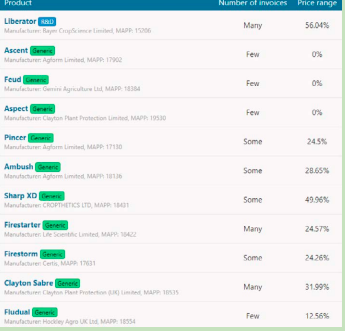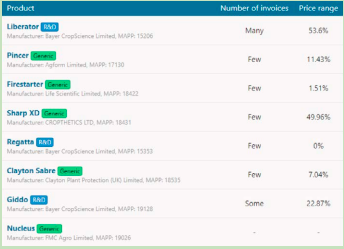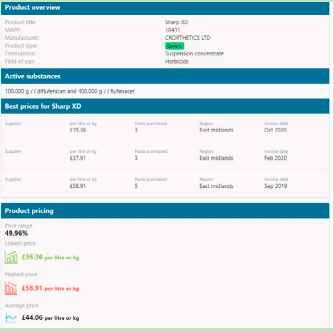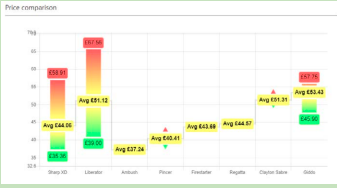Written by Chris Fellows
Last month I got chatting to a driver delivering chemicals to the farm, and he got around to asking what I was doing that day. I was in fact working on a new service we are developing called Farm Compare, which is designed to help farmers buy more efficiently. I wasn’t sure how well this would go down, but his response was interesting. “Great” he said. “My next five deliveries are single drums of chemical to each farm. Maybe you’ll teach them to buy in more sensible quantities”. Farm deliveries are peculiarly wasteful. The delivery driver understands that dropping off a single drum is far from efficient; and the average housewife knows that buying a four pack of baked beans is more cost effective than buying singles as well. But despite this knowledge this driver was going to drive 45 minutes to get to the five different farms. That is not efficient, and the cost of that inefficiency is being paid for by farmers. In one way or another.
What is the issue?
The fault here doesn’t totally lie with farmers who like to get the goods they need when they need them. They don’t know that they are paying a premium price for getting single drums, because they don’t know the quantity discount. And the distributors pride themselves in their ability to deliver products as an when needed, one at a time if required. The scenario gets worse as the farmer only orders exactly what he needs for any job. In industry it is ‘Just-In-Time Procurement’. The supplier holds the stock and delivers little and often. It can be efficient for the farmer but is massively inefficient for the distributor. If so, why should the farmer be interested in making a change to this supply system? The reason is that every supplier has to load the distribution costs on to the price of the product. Everyone is a loser.
Enter Farm Compare
Here is a free price comparison and product lookup tool for farmers for crop protection products. It’s a simple idea which depends on the involvement of lots of farmers. If you contribute the prices which you have had to pay for product, you can then see the prices others have paid. It also shows the quantities in each order, revealing the quantity discount. There is no cost to use it.
The aim of Farm Compare is for you to see not just the price, but how was that price achieved. what quantities are ordered generally. Where was the delivery location? Remote or central? How many packs were ordered to achieve it? When was it? In high season to be used immediately or off-season? Was the product R&D, a generic or a parallel. There are lots of questions and Farm Compare gives you the answers. You can even compare prices from one equivalent product to another. That’s not to say they are exactly the same, just that they include the same chemistry.
Knowing this information helps you buy better. Buying all your requirements product once and early in the year (by guessing your need) could have been the way to get the best price. But you also might have over-ordered and left with stock that could deteriorate. The buying risk is moving to the farmer, so the price paid should reflect that. For instance – most of us will use something like a Liberator. Did you know there have been 29 different products produced using the same chemistry in the last 18 months? That’s right, 29 equivalents for just one product. And the price difference on all of them are different. Here are just a few of them:

To see a price range is normal. You would expect there to be a difference between buying 1 pack and 50 packs. As the prices quoted also often include delivery, you might also expect a differential by location. For that reason, we have included filters for location. The above data is national, but you can also run a search for your region. This table is for the East Midlands:

Obviously, the more filters you apply, the fewer number of overall prices there will be to compare with, but the more relevant those prices will be for you. By the way, everything you are seen so far is available to all, even if you don’t want to see more detailed information. If you just want to see what the equivalents are, then you can run those searches as often as you want. During the testing phase I’ve used it a lot myself, so we hope it will be a really simple but useful tool in every farmer’s pocket. If you have submitted prices then you can move to the next page, which gives you even more detail. This is what more detail looks like:

That however is just the prices for that product, and most of us are happy to use equivalents. The equivalent prices are also really useful. This is the graph Farm Compare produces to help you:

If you lived in the East Midlands, then the best prices were for Sharp XD, but there was also quite a range and that product. Pincer and Ambush gave the best average prices, with very little deviation from these prices. All prices are displayed per litre or Kg, this is so you can compare the prices where products are supplied in multiple pack sizes. Where you have bought that product or an equivalent, then your price also shows on this graph.
As a farmer you can run this same search for every product you bought last year if you want to do some benchmarking on farm performance. You can also run a search for every product you want to buy. Giving you a bit of market information to help you chose what products and where to buy them. Did you even know there was a product called Regatta? I didn’t before writing this and I feel I get to see a lot of crop protection products being involved in marketing them. Farm compare gives you all this information to help you with your buying decisions. It also helps you learn product names!
Price Transparency
The aim of this system of course is to create price transparency. This is the natural evolution of all markets. Let’s face it, if you were buying a TV you would be checking different sites, Google shopping for instance to see where the same product was for sale at different prices. You might not even buy the cheapest. You might buy the one that can deliver tomorrow. You might buy the one from the company how give you a line of credit. That’s normal in our lives. However, you can buy a 60 inch TV for the price of a couple of packs of Liberator, so why not take the same care when buying your crop protection products? Farm compare is a bit like Google Shopping for crop protection products, with a bit more information thrown in and just like all Google services it is all available for free. In fact, you can find quite a few crop protection products on Google Shopping already.
What next?
While you can now find out the best places and times to buy every product, the optimum buying year cannot really be achieved. For a start, we may not have accounts with all the suppliers, then we probably don’t need products in the volume to get the optimum price. But we have a guide for every product. But what would be useful is to know more macro decisions, such as:
• How much in total am I buying above or below the group average?
• If I was to buy from one supplier, who would be the best supplier for me?
• If I was to select two suppliers, who should I buy from?
• If I am a supply customer paying £15/18/20 a hectare walking fee (insert your own figure), would I be better off as a serviced customer?
• If I am a serviced customer, what could I afford to pay per hectare as a walking fee and move to supply only and be better off?
Strategy questions like this, will help farmers guide their businesses. Dealing with one or two suppliers is practical, dealing with 10 isn’t. Not impossible, just not practical. Being serviced also gives you more guarantees than being supply only, so that carries a price, even if it’s more like an insurance policy. These are all decisions we need to make as farmers, all it requires is a transparent system like Farm Compare to allow us to make them. Within a year, the system will also be able to answer these questions for you. All you need to do, is make some time to use it.
